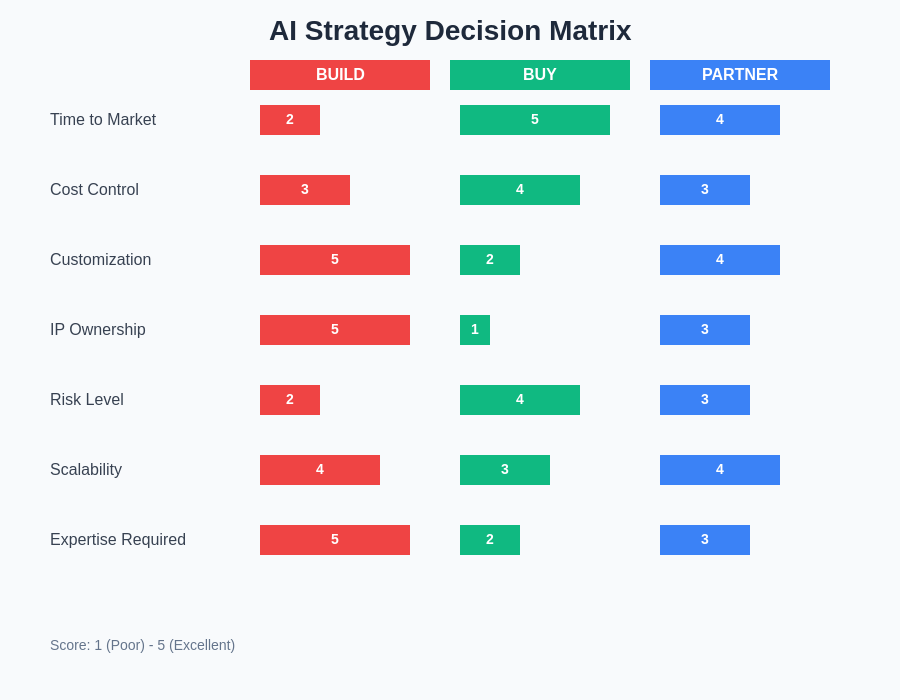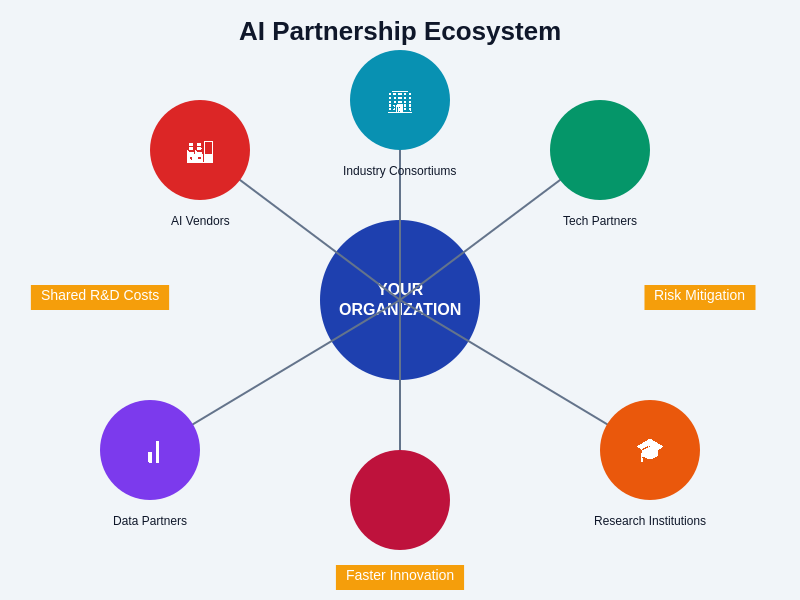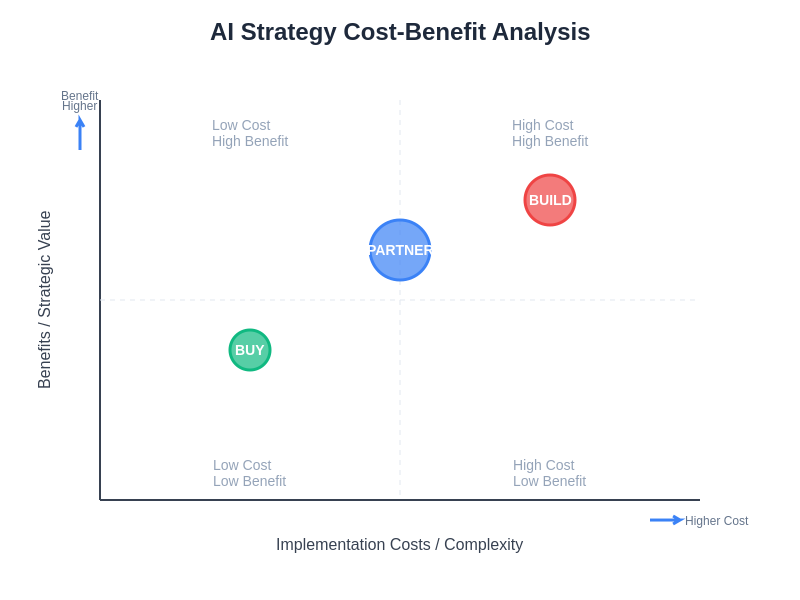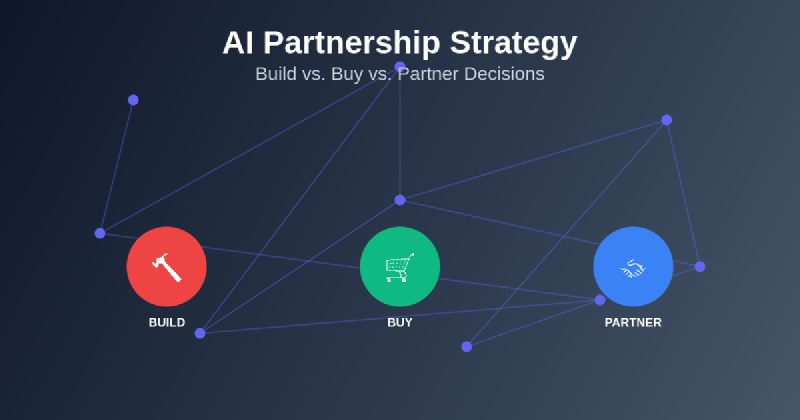The artificial intelligence revolution has reached a critical juncture where organizations across all industries must make strategic decisions about how to integrate AI capabilities into their operations. The fundamental question facing business leaders and technology executives today is not whether to adopt AI, but rather how to approach this adoption most effectively. The strategic decision between building AI solutions in-house, purchasing existing platforms, or forming strategic partnerships represents one of the most consequential choices that will determine an organization’s competitive positioning and long-term success in the AI-driven economy.
Stay updated with the latest AI partnership trends to understand how leading organizations are navigating these complex strategic decisions. The landscape of AI implementation continues to evolve rapidly, with new opportunities and challenges emerging as technology advances and market dynamics shift. Understanding the nuances of each approach and the factors that influence optimal decision-making has become essential for organizations seeking to leverage AI effectively while minimizing risks and maximizing return on investment.
Understanding the Strategic Landscape
The AI implementation landscape presents organizations with three primary strategic pathways, each carrying distinct advantages, challenges, and implications for long-term competitiveness. The build approach involves developing AI capabilities internally, leveraging existing technical resources and building custom solutions tailored to specific organizational needs. The buy approach focuses on acquiring existing AI platforms, tools, or services from established vendors who have already invested in developing sophisticated AI capabilities. The partner approach involves forming strategic alliances with AI specialists, technology providers, or other organizations to jointly develop or deploy AI solutions that benefit all parties involved.
The complexity of this decision-making process has increased significantly as AI technologies have matured and diversified. Organizations must consider not only the immediate technical and financial implications of their chosen approach but also the long-term strategic consequences for their market position, competitive advantage, and organizational capabilities. The rapid pace of AI development means that decisions made today will have lasting impacts on an organization’s ability to adapt and innovate in an increasingly AI-centric business environment.
The strategic importance of these decisions extends beyond the technology department and impacts every aspect of organizational operations, from customer experience and operational efficiency to risk management and competitive differentiation. Business leaders must evaluate their organization’s unique circumstances, resources, and objectives while considering the broader market dynamics and technological trends that will shape the future of their industry.

This comprehensive decision framework provides a systematic approach to evaluating the three primary AI implementation strategies across critical criteria including time to market, cost control, customization capabilities, intellectual property ownership, risk levels, scalability potential, and required expertise. Understanding how each strategy performs against these key factors enables organizations to make informed decisions that align with their specific objectives and constraints.
The Build Strategy: Internal Development Advantages
Building AI capabilities internally offers organizations the opportunity to create highly customized solutions that align perfectly with their specific business requirements, operational workflows, and strategic objectives. This approach provides maximum control over the development process, allowing organizations to prioritize features and functionality that deliver the greatest value to their particular use cases. Internal development also ensures that AI solutions can be seamlessly integrated with existing systems, processes, and data infrastructure, creating synergies that may not be achievable with external solutions.
The intellectual property advantages of building AI capabilities internally cannot be overstated. Organizations that develop their own AI systems retain complete ownership of the algorithms, models, and innovations they create, providing long-term competitive advantages and potential revenue opportunities through licensing or commercialization. This ownership also provides greater flexibility in modifying, enhancing, or scaling AI solutions as business needs evolve, without being constrained by vendor roadmaps or licensing restrictions.
Explore advanced AI development with Claude to understand how sophisticated AI tools can accelerate internal development efforts while maintaining full control over proprietary solutions. The build approach also enables organizations to develop deep AI expertise within their workforce, creating valuable human capital that can drive continued innovation and adaptation as AI technologies advance. This internal expertise becomes a strategic asset that can inform future technology decisions and provide competitive intelligence about emerging AI trends and opportunities.
Building AI capabilities internally also provides organizations with greater transparency and understanding of how their AI systems operate, make decisions, and handle sensitive data. This transparency is particularly valuable for organizations operating in regulated industries or handling sensitive information where algorithmic accountability and explainability are critical requirements. Internal development allows for the implementation of custom governance frameworks, audit trails, and compliance mechanisms that may not be available in commercial AI solutions.
Build Strategy: Challenges and Considerations
Despite its advantages, the build strategy presents significant challenges that organizations must carefully evaluate before committing to internal AI development. The most immediate challenge involves the substantial investment in human resources required to build and maintain AI capabilities. Organizations must attract and retain highly skilled data scientists, machine learning engineers, AI researchers, and related technical professionals who command premium salaries and are in high demand across the industry.
The technical infrastructure requirements for building AI capabilities internally can be substantial, requiring investments in computing resources, data storage systems, development tools, and specialized hardware such as graphics processing units for machine learning workloads. Organizations must also establish robust data governance frameworks, security protocols, and compliance mechanisms to ensure that their AI development efforts meet regulatory requirements and industry standards.
The time-to-market considerations for internal AI development can be significant, particularly for organizations that lack existing AI expertise or infrastructure. Building sophisticated AI solutions from scratch typically requires months or years of development time, during which competitors may gain market advantages by leveraging existing AI solutions or partnerships. This extended development timeline can also mean that by the time internal solutions are ready for deployment, the underlying business requirements or market conditions may have changed significantly.
Organizations pursuing the build strategy must also consider the ongoing maintenance and evolution requirements for their AI systems. Unlike traditional software applications, AI models require continuous monitoring, retraining, and updating to maintain their effectiveness as data patterns change and business requirements evolve. This ongoing maintenance represents a permanent commitment of resources and expertise that organizations must factor into their long-term planning and budgeting processes.
The Buy Strategy: Commercial Solution Benefits
The buy strategy offers organizations the opportunity to quickly access sophisticated AI capabilities that have been developed and refined by specialized vendors with deep expertise in artificial intelligence. Commercial AI solutions typically provide immediate access to advanced algorithms, pre-trained models, and user-friendly interfaces that can be deployed rapidly without requiring extensive internal AI expertise. This approach allows organizations to benefit from the research and development investments made by AI vendors while focusing their internal resources on core business activities.
Commercial AI platforms often provide comprehensive support services, including implementation assistance, training programs, ongoing technical support, and regular updates that incorporate the latest AI advancements. These support services can significantly reduce the burden on internal IT teams and help ensure successful AI adoption across the organization. Vendor-provided training and certification programs also help build internal AI literacy without requiring organizations to develop comprehensive AI expertise from scratch.
The cost predictability associated with commercial AI solutions can be attractive for organizations seeking to manage their technology budgets effectively. Subscription-based pricing models, usage-based fees, and transparent licensing structures help organizations plan and budget for their AI initiatives without the uncertainty associated with internal development projects. Commercial solutions also often provide flexible scaling options that allow organizations to adjust their AI capabilities based on changing business needs without significant infrastructure investments.
Commercial AI vendors typically maintain partnerships with other technology providers, creating ecosystems of integrated solutions that can address diverse business requirements. These ecosystem partnerships can provide organizations with access to complementary technologies, data sources, and services that enhance the value of their AI investments. The vendor’s ongoing relationships with other technology providers also help ensure compatibility and interoperability as technology platforms evolve.
Buy Strategy: Limitations and Dependencies
While commercial AI solutions offer many advantages, organizations must carefully consider the potential limitations and dependencies associated with this approach. Vendor lock-in represents a significant risk, particularly when organizations build their processes and workflows around proprietary AI platforms that cannot be easily replaced or migrated to alternative solutions. This dependency can limit future flexibility and potentially expose organizations to vendor-driven price increases, feature changes, or service discontinuations.
The customization limitations of commercial AI solutions may not align perfectly with unique organizational requirements or industry-specific use cases. While vendors often provide configuration options and customization capabilities, these may not be sufficient for organizations with highly specialized needs or complex integration requirements. The standardized nature of commercial solutions may also limit competitive differentiation opportunities compared to custom-built alternatives.
Data privacy and security concerns can be particularly significant when using commercial AI solutions, especially for organizations handling sensitive information or operating in regulated industries. Organizations must carefully evaluate vendor security practices, data handling policies, and compliance certifications to ensure that commercial AI solutions meet their risk management requirements. The shared infrastructure and multi-tenant architectures common in commercial AI platforms may also raise concerns about data isolation and competitive information protection.
Leverage Perplexity for comprehensive AI research to thoroughly evaluate commercial AI solutions and understand their capabilities, limitations, and strategic implications for your organization. The ongoing dependency on vendor roadmaps and development priorities can also impact long-term strategic planning, as organizations have limited influence over feature development, performance improvements, or integration priorities that may be critical to their success.
The Partnership Strategy: Collaborative Advantages
Strategic partnerships represent a hybrid approach that can combine the benefits of both internal development and commercial solutions while mitigating many of the associated risks and limitations. Partnership strategies can take various forms, including joint development initiatives, technology licensing agreements, data sharing partnerships, or collaborative research projects that leverage the complementary strengths of different organizations. These collaborative approaches often provide access to specialized expertise, shared development costs, and accelerated innovation cycles that would be difficult to achieve independently.
Technology partnerships with AI specialists or research institutions can provide organizations with access to cutting-edge research, advanced algorithms, and deep technical expertise without requiring significant internal investments in AI talent acquisition and retention. These partnerships often include knowledge transfer components that help build internal AI capabilities while leveraging external expertise to accelerate initial implementation and deployment efforts.
Data partnerships represent another valuable form of AI collaboration, particularly for organizations that may have valuable data assets but lack the AI expertise to fully leverage them, or conversely, organizations with strong AI capabilities that need access to diverse, high-quality data sets. These partnerships can create mutually beneficial arrangements where data providers gain access to AI insights and capabilities while AI specialists gain access to the data needed to develop and train sophisticated models.

The modern AI partnership ecosystem encompasses diverse relationships with technology vendors, research institutions, data partners, cloud providers, and industry consortiums. Each partnership type offers unique advantages including shared research and development costs, risk mitigation, accelerated innovation cycles, and access to specialized expertise that would be difficult or expensive to develop internally.
Industry consortium partnerships and collaborative research initiatives can help organizations share the costs and risks associated with AI development while contributing to broader industry advancement and standardization efforts. These collaborative approaches are particularly valuable for addressing common industry challenges, developing shared standards, or creating AI solutions that benefit entire ecosystems of organizations.
Partnership Strategy: Implementation Complexities
While partnership strategies offer significant advantages, they also introduce complexities related to governance, intellectual property management, and operational coordination that organizations must carefully manage to achieve success. Establishing clear governance frameworks that define roles, responsibilities, decision-making processes, and conflict resolution mechanisms is essential for maintaining productive partnership relationships and ensuring that collaborative AI initiatives deliver expected outcomes.
Intellectual property considerations become particularly complex in partnership arrangements, requiring careful negotiation and documentation of ownership rights, usage permissions, and commercialization opportunities for jointly developed AI solutions. Organizations must balance the desire to protect their proprietary assets and competitive advantages with the need to create mutually beneficial arrangements that incentivize meaningful collaboration and knowledge sharing.
The operational challenges associated with coordinating AI development efforts across multiple organizations can be significant, particularly when partners have different technical architectures, development methodologies, or project management approaches. Establishing effective communication protocols, shared development environments, and compatible data integration processes requires careful planning and ongoing management attention to ensure successful collaboration.
Cultural and strategic alignment between partnership organizations is crucial for long-term success, as differences in organizational priorities, risk tolerance, or strategic direction can create tensions that undermine collaborative AI initiatives. Organizations must invest time and effort in building strong relationships with their partners and maintaining alignment on shared objectives and success metrics throughout the partnership lifecycle.
Decision Framework: Evaluating Strategic Options
Developing an effective decision framework for evaluating AI implementation strategies requires organizations to systematically assess their internal capabilities, strategic objectives, resource constraints, and market position relative to the available options. The first step in this evaluation process involves conducting a comprehensive assessment of internal AI readiness, including existing technical expertise, data infrastructure, development resources, and organizational commitment to AI initiatives.
Organizations must also evaluate their specific AI requirements, including the complexity and uniqueness of their use cases, integration requirements, performance expectations, and compliance obligations. Use cases that require highly specialized algorithms, proprietary data processing, or deep integration with existing systems may favor internal development approaches, while more standardized applications may be well-suited to commercial solutions or partnership arrangements.
Resource availability represents another critical factor in the decision-making process, encompassing not only financial resources but also human capital, time constraints, and organizational bandwidth for managing AI initiatives. Organizations with limited AI expertise or tight implementation timelines may benefit from commercial solutions or partnerships that provide immediate access to capabilities and support services.
Market dynamics and competitive considerations should also inform strategic decision-making, including the pace of industry change, competitive threats, and opportunities for differentiation through AI capabilities. Organizations operating in rapidly evolving markets may need to prioritize speed-to-market through commercial solutions or partnerships, while those seeking to establish competitive moats may benefit from proprietary internal development efforts.

This strategic positioning analysis illustrates how different AI implementation approaches balance costs and benefits. The build strategy typically offers high strategic value but requires significant investment, while commercial solutions provide faster deployment at lower initial costs but with limited differentiation potential. Partnership approaches often provide the optimal balance of moderate costs with substantial strategic benefits through shared resources and collaborative innovation.
Risk Assessment and Mitigation Strategies
Each AI implementation strategy carries distinct risk profiles that organizations must carefully evaluate and address through appropriate mitigation strategies. Internal development risks include cost overruns, extended timelines, talent retention challenges, and the possibility that developed solutions may not meet performance expectations or market requirements. Organizations can mitigate these risks through phased development approaches, prototype validation, external consulting support, and careful project management and governance processes.
Commercial solution risks include vendor dependency, limited customization options, data security concerns, and potential service disruptions or vendor business failures. Risk mitigation strategies for commercial solutions include multi-vendor approaches, contractual service level agreements, data portability requirements, and contingency planning for vendor transitions or service interruptions.
Partnership risks encompass governance challenges, intellectual property disputes, cultural misalignment, and dependency on partner organizations for critical capabilities. Organizations can address these risks through comprehensive partnership agreements, clear governance structures, regular performance reviews, and backup plans that reduce dependence on any single partner relationship.
Regardless of the chosen strategy, organizations should implement comprehensive risk monitoring and management processes that track key performance indicators, identify emerging risks, and enable rapid response to changing circumstances. Regular strategy reviews and adjustment mechanisms help ensure that AI implementation approaches remain aligned with organizational objectives and market conditions as they evolve over time.
Implementation Success Factors
Successful AI implementation, regardless of the chosen strategy, requires strong organizational commitment, clear success metrics, and effective change management processes that help organizations adapt to new AI-enabled workflows and capabilities. Leadership support and championship are essential for overcoming implementation challenges, securing necessary resources, and driving organizational adoption of AI solutions.
Building internal AI literacy and capabilities represents another critical success factor, even for organizations that choose to purchase commercial solutions or rely heavily on partnerships. Understanding AI fundamentals, data requirements, and ethical considerations helps organizations make better decisions about AI applications, manage vendor relationships more effectively, and identify opportunities for continuous improvement and innovation.
Data quality and governance foundations are essential for successful AI implementation across all strategies, as AI systems depend on access to high-quality, well-organized data to deliver meaningful insights and capabilities. Organizations must invest in data infrastructure, governance processes, and quality management systems that support their chosen AI implementation approach and enable long-term success.
Continuous monitoring, evaluation, and optimization processes help ensure that AI implementations deliver expected benefits and continue to provide value as business requirements and market conditions evolve. Regular performance assessments, user feedback collection, and strategy refinement processes enable organizations to maximize their return on AI investments and maintain competitive advantages over time.
Future Considerations and Strategic Evolution
The AI landscape continues to evolve rapidly, with new technologies, business models, and competitive dynamics emerging regularly that may impact the relative advantages and disadvantages of different implementation strategies. Organizations must maintain awareness of these evolving trends and be prepared to adapt their AI strategies as circumstances change and new opportunities emerge.
The increasing commoditization of certain AI capabilities may shift the strategic balance toward commercial solutions and partnerships for standardized applications, while creating new opportunities for competitive differentiation through specialized internal development in areas that remain unique to specific organizations or industries. This evolution requires ongoing strategic assessment and flexibility in implementation approaches.
Regulatory developments and ethical considerations are likely to play increasingly important roles in AI strategy decisions, potentially favoring approaches that provide greater transparency, control, and accountability over AI systems and their decision-making processes. Organizations must consider how different implementation strategies position them to address evolving regulatory requirements and stakeholder expectations around responsible AI use.
The emergence of new AI technologies, such as advanced language models, computer vision systems, and autonomous agents, will continue to create new strategic opportunities and challenges that may favor different implementation approaches depending on the specific capabilities and requirements involved. Organizations that maintain strategic flexibility and adapt their approaches based on changing technology landscapes will be better positioned to capitalize on emerging AI opportunities while managing associated risks effectively.
Disclaimer
This article is for informational purposes only and does not constitute professional business or technology advice. The views expressed are based on current understanding of AI technologies and strategic considerations that may vary depending on specific organizational circumstances, industry requirements, and regulatory environments. Readers should conduct thorough analysis of their specific situations and consult with qualified professionals when making strategic AI implementation decisions. The effectiveness of different AI strategies may vary significantly based on organizational capabilities, market conditions, and technology evolution.
